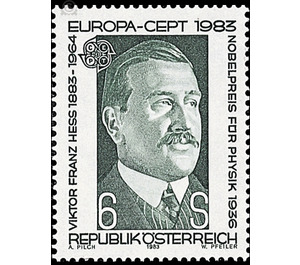100th birthday - Austria / II. Republic of Austria 1983 - 6 Shilling
Theme: Post & Philately
| Country | Austria / II. Republic of Austria |
| Issue Date | 1983 |
| Face Value | 6.00 |
| Color | multi-colored orange |
| Printing Type | Typography |
| Stamp Type | Commemorative |
| Item Type | Stamp |
| Chronological Issue Number | 1086 |
| Chronological Chapter | OOS-OE2 |
| SID | 658524 |
| In 56 Wishlists | |
Victor Franz Hess was born on June 27, 1883 at Schloss Waldstein (near Deutschfeistritz, north of Graz). After attending grammar school in Graz, Victor Hess studied physics at the university there from 1901 onwards. In 1906 he received his doctorate and in 1910, when the newly founded Institute for Radium Research of the Austrian Academy of Sciences was opened, appointed his first assistant under Stefan Meyer. In 1925 he became a full professor at the University of Graz, later he moved to the University of Innsbruck. Hess studied the effects of radioactive substances in the atmosphere and in 1911 discovered cosmic rays. For this he received the Nobel Prize for Physics in 1936. In 1937 he followed a renewed appointment to Graz. But already in the following year, after the "Anschluss" of Austria by Hitler, he was forcibly retired. At the end of 1938, he was appointed to Fordham University, New York, where he taught until 1956. In 1944 he received American citizenship. In 1959 he was awarded the Austrian Decoration of Science and Art. On December 17, 1964, he died at the age of 81 in Mt. Vernon, New York State. Hess' scientific legacy includes 60 publications and several books.


